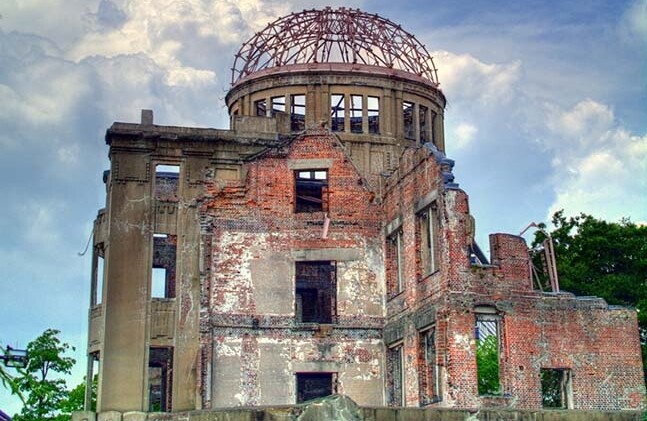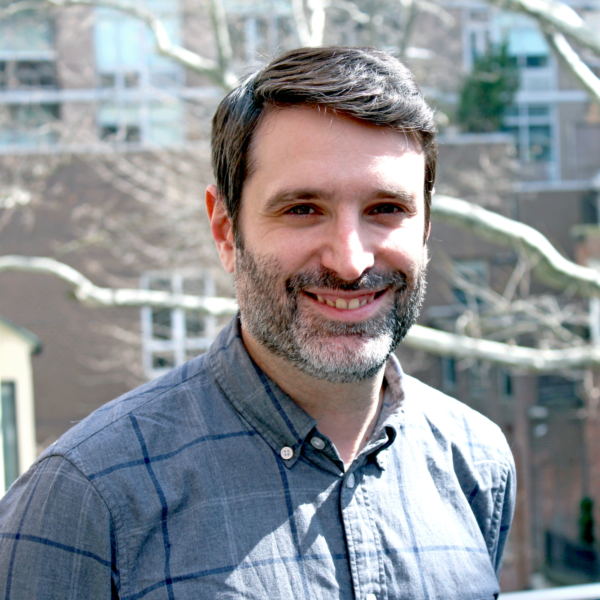Overview
The documentary In My Lifetime tells two stories. One is about the history of the atomic bomb and the other concerns the history of the anti-nuclear weapon movement. Both are explored through archival footage, contemporary interviews, and chilling scenes illustrating the immediate and long-term effects of these weapons, “the very end point of logic,” as nuclear expert Hugh Gusterson describes them.
As the documentary shows in great detail, the advent of nuclear weaponry means that for the first time, humanity has the power to destroy itself. Footage of Robert Oppenheimer, the so-called “father of the atomic bomb,” crying as he compares himself to Hindu god Vishnu, the “destroyer of worlds,” and first-hand accounts from survivors of the Hiroshima bombing describing a “pillar of fire,” drive this point home in the opening minutes. But perhaps, the most disturbing scene is of a chorus of elderly Hikabusha, or survivors of the atomic blasts in Japan, tearfully imploring the world through song to never use nuclear weapons again.
From there, the documentary gives a brief history of nuclear weapons, complete with an illustration of nuclear fission and the story of the origin of the term “atom bomb,” first found in an H.G. Wells novel. Albert Einstein and Leo Szilard’s letter to President Franklin Delano Roosevelt warning him about nuclear weapons is also showcased. In another illuminating scene, Gusterson recounts how a Soviet nuclear scientist says he felt “euphoric” when his country developed the bomb. As the Cold War kicks into full force, a cartoon turtle shows American kids how to “duck and cover” and thousands of test bombs are exploded, many in Nevada.
The history lesson is interspersed throughout the rest of the film, with sections on the Cuban Missile Crisis; the Non-Proliferation Treaty (NPT); atomic weapons in China, the UK, India, and Pakistan; and President Ronald Reagan and General Secretary Mikhail Gorbachev’s 1986 nuclear summit in Iceland. Scenes from the anti-nuclear movement are similarly featured. Radiation sickness in Hiroshima and Nagasaki is explained and shown in excruciating detail and a successful protest at the nuclear facility in Greenham Commons in England is also featured. In another scene, the secretary of state of Nevada’s Western Shoshone Nation, where a majority of the nuclear tests were conducted, is describes the effects of the U.S. atomic program on his people. This illuminates the point that even those test bombings in the sparsely populated Nevada desert are not victimless.
There is another side to nuclear weapons, though, beyond death, destruction, warfare, and politics. As Face to Face with the Bomb author Paul Shambroom, who documented nuclear facilities in the U.S., says:
“In some ways what struck me most was the ordinariness of the whole endeavor. I saw ordinary men and women going to work and doing their jobs. Perhaps at some level when they started their jobs, [they] had some significance of the materials that they were working with but I think after a while it’s just going to work for them. And I guess what left me thinking was . . . just how easy it is to become numb to what it is we’ve created.”
The haunting images of In My Lifetime, however—the destruction of Hiroshima and Nagasaki and the horrors of radiation sickness, the unprecedented power of hydrogen and thermonuclear weapons, the visible burden of the Manhattan Project scientists—will ensure that whoever watches the movie will never be numb to threat of nuclear war.
Ethical Issues and Discussion Questions
1. Does this film change your views on nuclear weapons at all, and if so, how?
2. Was the United States justified in dropping the bombs on Hiroshima and Nagasaki?
3. The footage from Hiroshima and Nagasaki, of course, makes a good case that atomic bombs are too horrible to ever be used again. However, can these same scenes also be used to make the case that atomic weapons are the best deterrent available? Did the immediate effects, as well as the longer-term effects, sway the thinking of the United States as to whether or not to use the bomb against the Soviets and vice versa?
4. Should Oppenheimer, Einstein, or any of the other scientists feel any guilt because they contributed to the building of these weapons?
5. At the meetings with General Secretary Gorbachev in Iceland, was President Reagan right to reject the proposal that would ban the United States from developing, testing, and deploying a defense against nuclear missiles for 10 years? Was he thinking about the safety of the “free world” or about maintaining the U.S. “military industrial complex”?
6. Does the United States have any justification for not ratifying the Comprehensive Nuclear-Test Ban Treaty?
7. Jayantha Dhanapala says, “There are no right hands for the possession of nuclear weapons.” Do you agree? Should nuclear weapons be completely abolished? Or are they useful as a deterrent?
8. In 2009, President Obama said, “As the only nuclear power to have used a nuclear weapon, the United States has a moral responsibility to act.” Do you agree? Should the United States set an example and destroy its nuclear arsenal? Or should the U.S. hold on to its arsenal as long as a country like North Korea has its own nuclear weapons?
9. Do you believe that North Korea has nuclear weapons only as a deterrent?
10. Is nuclear energy viable? With Chernobyl and Fukushima in mind, is nuclear power too risky?
11. Are nuclear weapons “the very end point of logic” as Gusterson says?
Selected Carnegie Council Resources
Senator Richard Lugar on Nuclear Weapons Reduction Senator Richard Lugar, Republican - IndianaSenator Lugar tells the dramatic story of his bipartisan work on the Cooperative Threat Reduction Program (also known as Nunn–Lugar), which provides funding and expertise for states in the former USSR nations to reduce nuclear weapons. (U.S. Global Engagment Program, October 2012)
European Security and Arms Control Sergey Rogov, Institute of U.S. and Canadian Studies of the Russian Academy of ScienceAlthough Russia and the West are confronting each other on a number of issues, it is premature to write off their strategic partnership. The New START Treaty establishes stability of the nuclear balance for the next decade. This will help them eventually move to mutual assured security. (U.S. Global Engagment Program, September 2011)
Arms Control and Proliferation Challenges to the Reset Policy Stephen J. Blank, Strategic Studies InstituteThe United States, Russia, and outside observers all agree on one thing: the fragility of the reset policy. This paper clarifies the reasons for this fragility and the consequences for arms control and future cooperation on nonproliferation issues. (U.S. Global Engagment Program, August 2011)
Beyond the NPT Roald Sagdeev, Space Research Institute; Frank von Hippel, Princeton UniversityDoctors Sagdeev and von Hippel have collaborated for decades on nuclear arms control and nonproliferation between the U.S. and the USSR, and now Russia. They discuss their work and their insights for the future arms control agenda. (U.S. Global Engagement Program, June 2010. Video, audio, transcript)
Bomb Power: The Modern Presidency and the National Security State Garry Wills, Northwestern University Garry Wills traces how the atomic bomb transformed our nation down to its deepest constitutional roots, defined the presidency, and redefined the government as a national security state. (Public Affairs Program, February 2010. Video, audio, transcript)
Red Cloud at Dawn: Truman, Stalin, and the End of the Atomic Monopoly Michael D. Gordin, Princeton University How does a state make a nuclear bomb? How does it hide its weapons program? How do other states detect nuclear proliferation? Gordin addresses important questions about how we think about nuclear weapons past and present. (Public Affairs Program, January 2010. Video, audio, transcript)
Prospects for Arms Control in the Obama Administration John Isaacs, Center for Arms Control and Non-ProliferationThere are an estimated 23,000 nuclear weapons on the planet. Although they have faded from the public consciousness somewhat, they remain one of the greatest dangers we face. Obama has provided an opportunity for unprecedented progress on this issue. Will he succeed? (U.S. Global Engagement Program, December 2009. Video, audio, transcript)
A Guide to the Challenges Facing President Obama's Nuclear Abolition Agenda Burgess Laird, National Security Analyst The case for nuclear weapons abolition recently advanced by President Obama is built not on the familiar refrain of disarmament advocates that nuclear weapons are inherently morally unjustifiable and destabilizing, but on pragmatic grounds. (U.S. Global Engagement Program article, July 2009)
North Korea: What Next?Victor D. Cha, Georgetown University There are no good options in negotiations with North Korea, says Bush's top advisor on North Korean affairs, Victor Cha. It's always a choice between a bad option and a worse option. (Public Affairs Program, June 2009. Video, audio, transcript)
Fallout, Denials, and Trials: Recognizing the Health Legacy of Nuclear Test Veterans David Willcox, Historian A UK court case brought by participants in the UK's nuclear testing program raises a moral dilemma for governments, writes David Willcox. (Carnegie Ethics Online article, April 2009)
Deterrence Beats Diplomacy on North Korea Robert Dujarric, Temple University, Japan campus The best reaction to the DPRK's WMD program is to maintain a high level of deterrence by ensuring that the U.S. has the visible ability to crush North Korea should Pyongyang choose the path of war. (Global Policy Innovations article, May 2009)
Reset Button Plus David C. Speedie, Carnegie Council The Obama mantra for U.S.-Russia relations is "hit the 'reset button,'" yet the Clinton years (1992-2000) were a mixed bag. We should aim for a "reset button plus," one that engages Russia on a host of issues that would directly serve America's self interest. (U.S. Global Engagement Program article, March 2009)
Arsenals of Folly: The Making of the Nuclear Arms Race Richard Rhodes, Stanford University It's time to finish the work that Reagan and Gorbachev began and get rid of all the nuclear weapons in the world, says Rhodes. And led by George Shultz, a group of Reagan-era hawks have a step-by-step proposal on how to do it. (Public Affairs Program, November 2007. Audio, transcript)
Nuclear Proliferation: A Delicate Balance Between Force and Diplomacy Joseph Cirincione, Ploughshares Fund We are at a nuclear tipping point, says Joseph Cirincione, and the policy decisions the United States makes over the next 3-5 years will decide whether or not we launch another great wave of nuclear proliferation. (Public Affairs Program, December 2006. Video, audio, transcript)
Nuclear Terrorism: The Ultimate Preventable Catastrophe Graham Allison, Harvard University Nuclear security expert Graham Allison gives a sobering assessment on why a nuclear attack on U.S. soil is inevitable unless we take immediate, well-concerted measures. (Public Affairs Program, November 2004. Audio, transcript)
Outside Links About In My Lifetime




